Retail Theory and Practice: Fashion Retail Analysis and Strategies
VerifiedAdded on 2023/01/18
|11
|3355
|69
Report
AI Summary
This report delves into the realm of retail theory and practice, offering a comprehensive analysis of the UK fashion industry with a specific focus on Marks & Spencer. The report begins with an introduction to retail, followed by an overview of Marks & Spencer's history, market position, and key offerings. A PESTEL analysis is conducted to examine the external factors influencing the company, including political, economic, social, technological, environmental, and legal aspects. The microenvironment is assessed using Porter's Five Forces, evaluating competitive intensity, supplier power, and customer bargaining power. The report further explores various strategies and tactics, such as social shopping, to enhance revenue and customer satisfaction. The report provides recommendations based on the findings, and concludes by summarizing the key insights and implications for Marks & Spencer's future success in the competitive fashion retail landscape. The report utilizes various statistics, tactics, and theories to identify the factors influencing retailers.

RETAIL THEORY
AND PRACTICE
AND PRACTICE
Paraphrase This Document
Need a fresh take? Get an instant paraphrase of this document with our AI Paraphraser
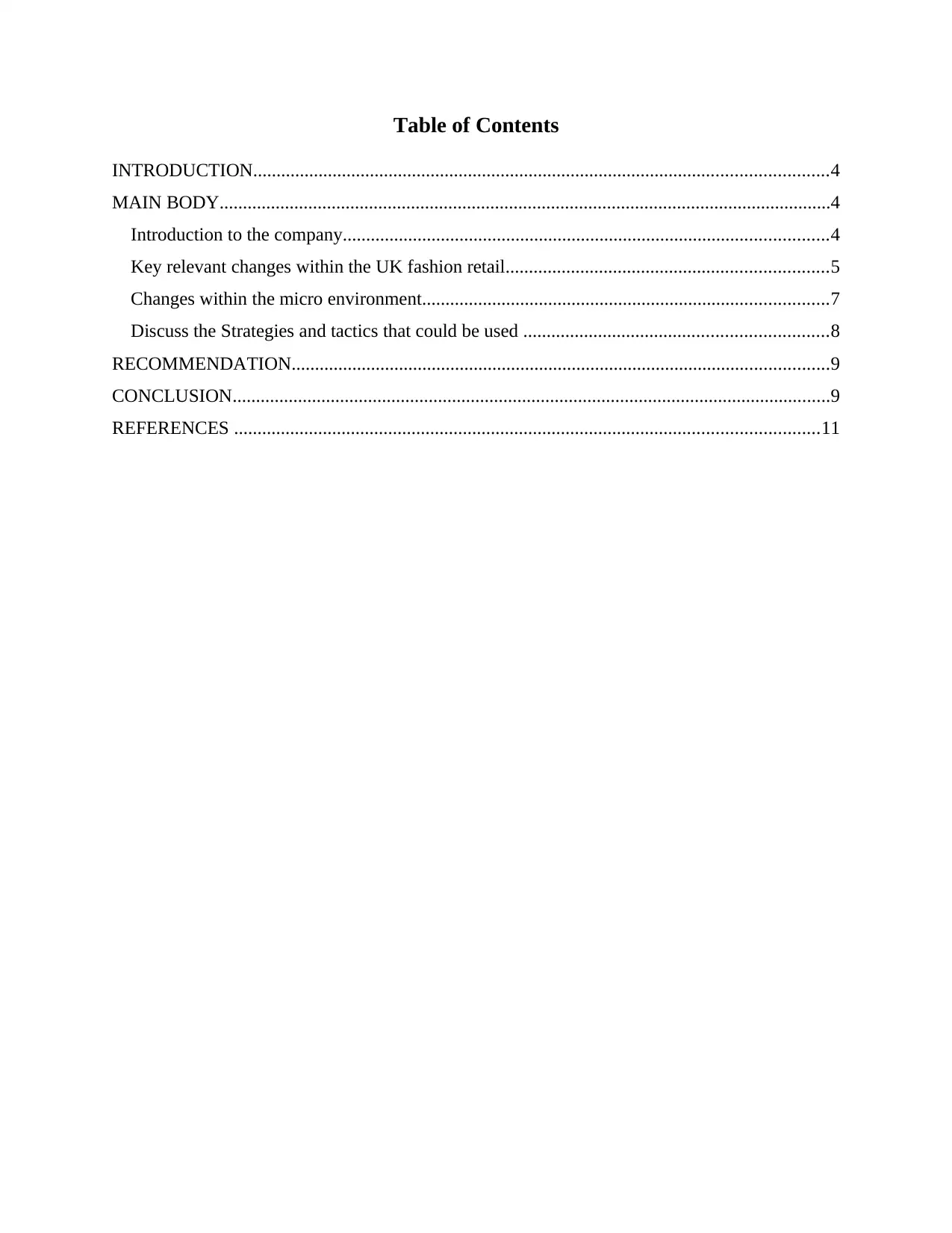
Table of Contents
INTRODUCTION...........................................................................................................................4
MAIN BODY...................................................................................................................................4
Introduction to the company........................................................................................................4
Key relevant changes within the UK fashion retail.....................................................................5
Changes within the micro environment.......................................................................................7
Discuss the Strategies and tactics that could be used .................................................................8
RECOMMENDATION...................................................................................................................9
CONCLUSION................................................................................................................................9
REFERENCES .............................................................................................................................11
INTRODUCTION...........................................................................................................................4
MAIN BODY...................................................................................................................................4
Introduction to the company........................................................................................................4
Key relevant changes within the UK fashion retail.....................................................................5
Changes within the micro environment.......................................................................................7
Discuss the Strategies and tactics that could be used .................................................................8
RECOMMENDATION...................................................................................................................9
CONCLUSION................................................................................................................................9
REFERENCES .............................................................................................................................11

⊘ This is a preview!⊘
Do you want full access?
Subscribe today to unlock all pages.

Trusted by 1+ million students worldwide

INTRODUCTION
Retail refers to the process of selling products and services to their respective customers
through their various channels of distribution which helps in earning profit and also they helps in
satisfying the demand which is identified through supply chain. The term retail is derived from
the French word Retailer. Retailers purchase in large quantity from the manufacturer and divide
the bulk in small quantity and then sell those products and services as per the demand and need
of customers (Ko, Phau, I. and Aiello, 2016). Retail marketing is an application of the marketing
functions in order to distribute the goods and services to their respective customers. Retail
industry includes many activities such as packaging, promotion, advertisements and showing the
variety of goods and products at a very reasonable price. Their purpose is to deliver the products
to their potential customers which can result in the customer satisfaction. The market share of
UK fashion industry is 7% and market value is approximately 66 billion pounds and currently
555,000 people are employed in fashion and retail industry (UK fashion industry statistics,
2019). moreover, there are top companies which are based on the market capitalization are
Burberry 10 billion dollar, Next 7.16 billion and Marks & Spencer 6.18 billion. This report is
going to focus on the various key elements of external and internal environment that influences
the company and also suggest some strategies and tactics by using various theories and
recommendations in order to overcome those barriers.
MAIN BODY
Introduction to the company
Marks & Spencer is the major British multinational retailer, headquarter in Westminster,
London. Company deals in the selling good quality clothing, home products and food products
and it is also listed on the London Stock Exchange. Company was founded in 1884 and currently
it has approximately 959 stores across UK and it includes 615 in food products. Marks &
Spencer was founded by two partners named Michael Marks and Thomas Spencer. Moreover,
they made their reputation in the early 20th century with the policy of selling British-made goods.
Furthermore, company has expanded into Canada in 1973 and had around 47 stores. Its profit
peaked in the financial year 1997-1998 and at that time company seen a continuous success story
(Company Archive, 2019). Furthermore, in 2006 company introduced a marketing campaign in
order to increase its sales and for this their slogan is “Look behind the label”. Its purpose is to
Retail refers to the process of selling products and services to their respective customers
through their various channels of distribution which helps in earning profit and also they helps in
satisfying the demand which is identified through supply chain. The term retail is derived from
the French word Retailer. Retailers purchase in large quantity from the manufacturer and divide
the bulk in small quantity and then sell those products and services as per the demand and need
of customers (Ko, Phau, I. and Aiello, 2016). Retail marketing is an application of the marketing
functions in order to distribute the goods and services to their respective customers. Retail
industry includes many activities such as packaging, promotion, advertisements and showing the
variety of goods and products at a very reasonable price. Their purpose is to deliver the products
to their potential customers which can result in the customer satisfaction. The market share of
UK fashion industry is 7% and market value is approximately 66 billion pounds and currently
555,000 people are employed in fashion and retail industry (UK fashion industry statistics,
2019). moreover, there are top companies which are based on the market capitalization are
Burberry 10 billion dollar, Next 7.16 billion and Marks & Spencer 6.18 billion. This report is
going to focus on the various key elements of external and internal environment that influences
the company and also suggest some strategies and tactics by using various theories and
recommendations in order to overcome those barriers.
MAIN BODY
Introduction to the company
Marks & Spencer is the major British multinational retailer, headquarter in Westminster,
London. Company deals in the selling good quality clothing, home products and food products
and it is also listed on the London Stock Exchange. Company was founded in 1884 and currently
it has approximately 959 stores across UK and it includes 615 in food products. Marks &
Spencer was founded by two partners named Michael Marks and Thomas Spencer. Moreover,
they made their reputation in the early 20th century with the policy of selling British-made goods.
Furthermore, company has expanded into Canada in 1973 and had around 47 stores. Its profit
peaked in the financial year 1997-1998 and at that time company seen a continuous success story
(Company Archive, 2019). Furthermore, in 2006 company introduced a marketing campaign in
order to increase its sales and for this their slogan is “Look behind the label”. Its purpose is to
Paraphrase This Document
Need a fresh take? Get an instant paraphrase of this document with our AI Paraphraser
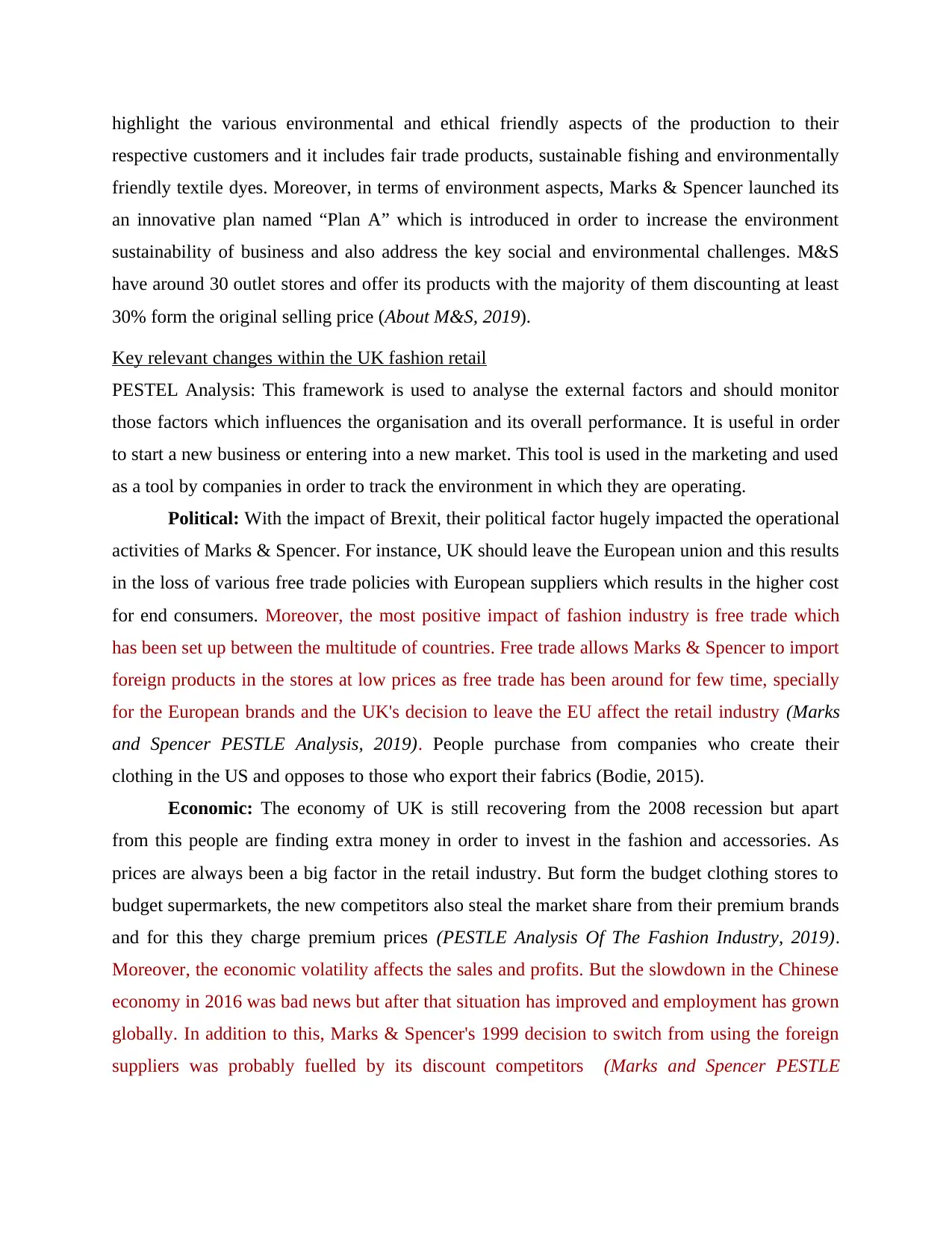
highlight the various environmental and ethical friendly aspects of the production to their
respective customers and it includes fair trade products, sustainable fishing and environmentally
friendly textile dyes. Moreover, in terms of environment aspects, Marks & Spencer launched its
an innovative plan named “Plan A” which is introduced in order to increase the environment
sustainability of business and also address the key social and environmental challenges. M&S
have around 30 outlet stores and offer its products with the majority of them discounting at least
30% form the original selling price (About M&S, 2019).
Key relevant changes within the UK fashion retail
PESTEL Analysis: This framework is used to analyse the external factors and should monitor
those factors which influences the organisation and its overall performance. It is useful in order
to start a new business or entering into a new market. This tool is used in the marketing and used
as a tool by companies in order to track the environment in which they are operating.
Political: With the impact of Brexit, their political factor hugely impacted the operational
activities of Marks & Spencer. For instance, UK should leave the European union and this results
in the loss of various free trade policies with European suppliers which results in the higher cost
for end consumers. Moreover, the most positive impact of fashion industry is free trade which
has been set up between the multitude of countries. Free trade allows Marks & Spencer to import
foreign products in the stores at low prices as free trade has been around for few time, specially
for the European brands and the UK's decision to leave the EU affect the retail industry (Marks
and Spencer PESTLE Analysis, 2019). People purchase from companies who create their
clothing in the US and opposes to those who export their fabrics (Bodie, 2015).
Economic: The economy of UK is still recovering from the 2008 recession but apart
from this people are finding extra money in order to invest in the fashion and accessories. As
prices are always been a big factor in the retail industry. But form the budget clothing stores to
budget supermarkets, the new competitors also steal the market share from their premium brands
and for this they charge premium prices (PESTLE Analysis Of The Fashion Industry, 2019).
Moreover, the economic volatility affects the sales and profits. But the slowdown in the Chinese
economy in 2016 was bad news but after that situation has improved and employment has grown
globally. In addition to this, Marks & Spencer's 1999 decision to switch from using the foreign
suppliers was probably fuelled by its discount competitors (Marks and Spencer PESTLE
respective customers and it includes fair trade products, sustainable fishing and environmentally
friendly textile dyes. Moreover, in terms of environment aspects, Marks & Spencer launched its
an innovative plan named “Plan A” which is introduced in order to increase the environment
sustainability of business and also address the key social and environmental challenges. M&S
have around 30 outlet stores and offer its products with the majority of them discounting at least
30% form the original selling price (About M&S, 2019).
Key relevant changes within the UK fashion retail
PESTEL Analysis: This framework is used to analyse the external factors and should monitor
those factors which influences the organisation and its overall performance. It is useful in order
to start a new business or entering into a new market. This tool is used in the marketing and used
as a tool by companies in order to track the environment in which they are operating.
Political: With the impact of Brexit, their political factor hugely impacted the operational
activities of Marks & Spencer. For instance, UK should leave the European union and this results
in the loss of various free trade policies with European suppliers which results in the higher cost
for end consumers. Moreover, the most positive impact of fashion industry is free trade which
has been set up between the multitude of countries. Free trade allows Marks & Spencer to import
foreign products in the stores at low prices as free trade has been around for few time, specially
for the European brands and the UK's decision to leave the EU affect the retail industry (Marks
and Spencer PESTLE Analysis, 2019). People purchase from companies who create their
clothing in the US and opposes to those who export their fabrics (Bodie, 2015).
Economic: The economy of UK is still recovering from the 2008 recession but apart
from this people are finding extra money in order to invest in the fashion and accessories. As
prices are always been a big factor in the retail industry. But form the budget clothing stores to
budget supermarkets, the new competitors also steal the market share from their premium brands
and for this they charge premium prices (PESTLE Analysis Of The Fashion Industry, 2019).
Moreover, the economic volatility affects the sales and profits. But the slowdown in the Chinese
economy in 2016 was bad news but after that situation has improved and employment has grown
globally. In addition to this, Marks & Spencer's 1999 decision to switch from using the foreign
suppliers was probably fuelled by its discount competitors (Marks and Spencer PESTLE
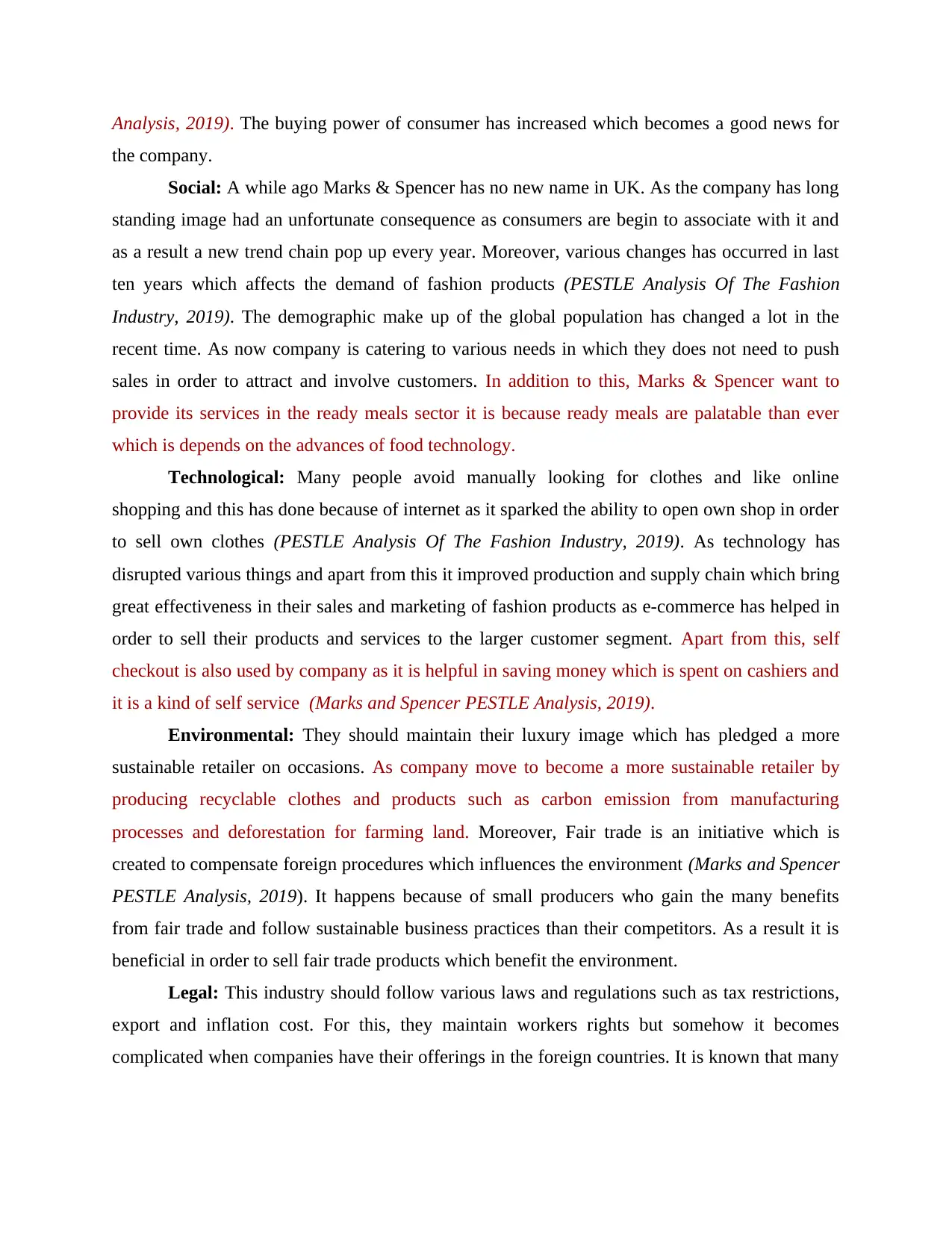
Analysis, 2019). The buying power of consumer has increased which becomes a good news for
the company.
Social: A while ago Marks & Spencer has no new name in UK. As the company has long
standing image had an unfortunate consequence as consumers are begin to associate with it and
as a result a new trend chain pop up every year. Moreover, various changes has occurred in last
ten years which affects the demand of fashion products (PESTLE Analysis Of The Fashion
Industry, 2019). The demographic make up of the global population has changed a lot in the
recent time. As now company is catering to various needs in which they does not need to push
sales in order to attract and involve customers. In addition to this, Marks & Spencer want to
provide its services in the ready meals sector it is because ready meals are palatable than ever
which is depends on the advances of food technology.
Technological: Many people avoid manually looking for clothes and like online
shopping and this has done because of internet as it sparked the ability to open own shop in order
to sell own clothes (PESTLE Analysis Of The Fashion Industry, 2019). As technology has
disrupted various things and apart from this it improved production and supply chain which bring
great effectiveness in their sales and marketing of fashion products as e-commerce has helped in
order to sell their products and services to the larger customer segment. Apart from this, self
checkout is also used by company as it is helpful in saving money which is spent on cashiers and
it is a kind of self service (Marks and Spencer PESTLE Analysis, 2019).
Environmental: They should maintain their luxury image which has pledged a more
sustainable retailer on occasions. As company move to become a more sustainable retailer by
producing recyclable clothes and products such as carbon emission from manufacturing
processes and deforestation for farming land. Moreover, Fair trade is an initiative which is
created to compensate foreign procedures which influences the environment (Marks and Spencer
PESTLE Analysis, 2019). It happens because of small producers who gain the many benefits
from fair trade and follow sustainable business practices than their competitors. As a result it is
beneficial in order to sell fair trade products which benefit the environment.
Legal: This industry should follow various laws and regulations such as tax restrictions,
export and inflation cost. For this, they maintain workers rights but somehow it becomes
complicated when companies have their offerings in the foreign countries. It is known that many
the company.
Social: A while ago Marks & Spencer has no new name in UK. As the company has long
standing image had an unfortunate consequence as consumers are begin to associate with it and
as a result a new trend chain pop up every year. Moreover, various changes has occurred in last
ten years which affects the demand of fashion products (PESTLE Analysis Of The Fashion
Industry, 2019). The demographic make up of the global population has changed a lot in the
recent time. As now company is catering to various needs in which they does not need to push
sales in order to attract and involve customers. In addition to this, Marks & Spencer want to
provide its services in the ready meals sector it is because ready meals are palatable than ever
which is depends on the advances of food technology.
Technological: Many people avoid manually looking for clothes and like online
shopping and this has done because of internet as it sparked the ability to open own shop in order
to sell own clothes (PESTLE Analysis Of The Fashion Industry, 2019). As technology has
disrupted various things and apart from this it improved production and supply chain which bring
great effectiveness in their sales and marketing of fashion products as e-commerce has helped in
order to sell their products and services to the larger customer segment. Apart from this, self
checkout is also used by company as it is helpful in saving money which is spent on cashiers and
it is a kind of self service (Marks and Spencer PESTLE Analysis, 2019).
Environmental: They should maintain their luxury image which has pledged a more
sustainable retailer on occasions. As company move to become a more sustainable retailer by
producing recyclable clothes and products such as carbon emission from manufacturing
processes and deforestation for farming land. Moreover, Fair trade is an initiative which is
created to compensate foreign procedures which influences the environment (Marks and Spencer
PESTLE Analysis, 2019). It happens because of small producers who gain the many benefits
from fair trade and follow sustainable business practices than their competitors. As a result it is
beneficial in order to sell fair trade products which benefit the environment.
Legal: This industry should follow various laws and regulations such as tax restrictions,
export and inflation cost. For this, they maintain workers rights but somehow it becomes
complicated when companies have their offerings in the foreign countries. It is known that many
⊘ This is a preview!⊘
Do you want full access?
Subscribe today to unlock all pages.

Trusted by 1+ million students worldwide
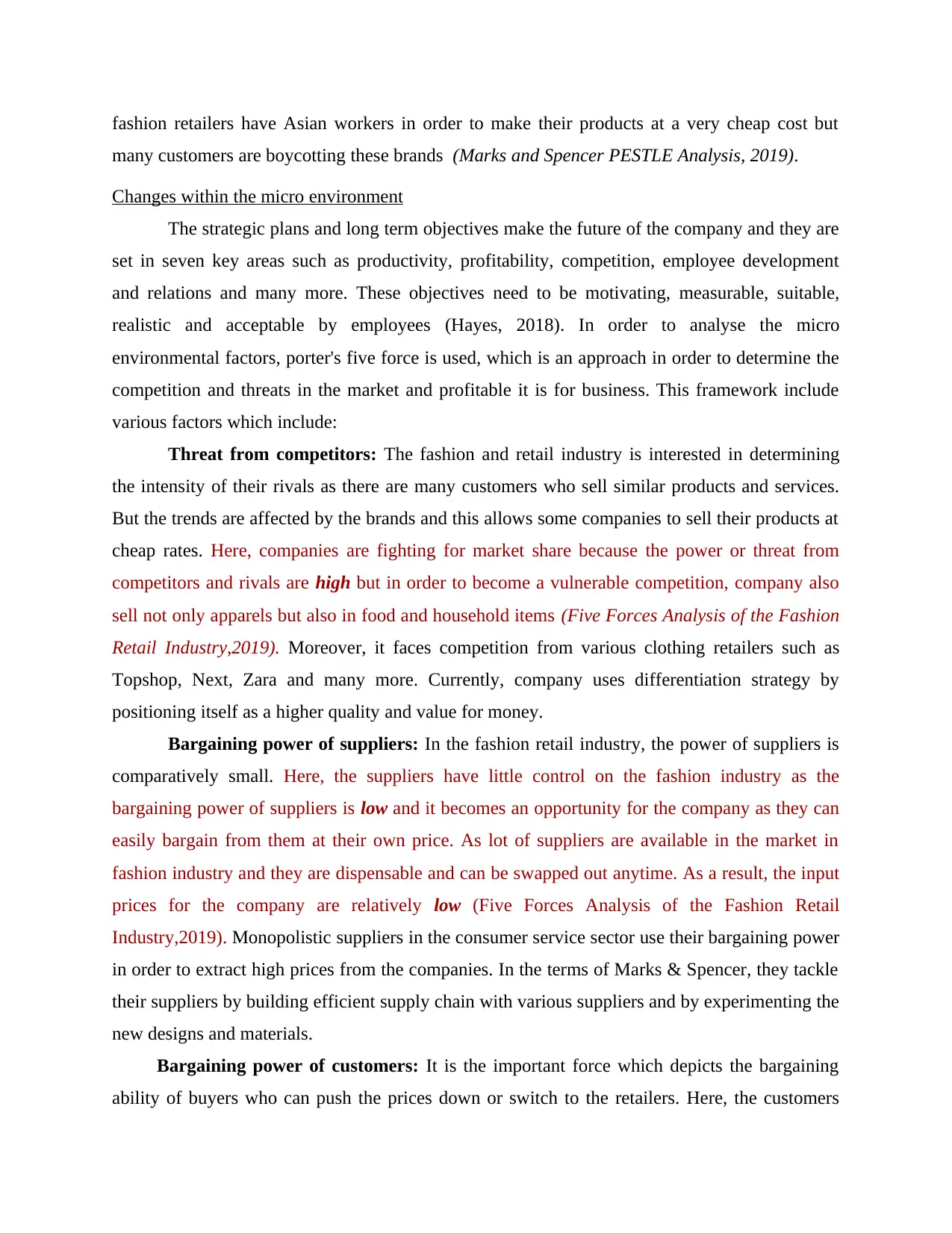
fashion retailers have Asian workers in order to make their products at a very cheap cost but
many customers are boycotting these brands (Marks and Spencer PESTLE Analysis, 2019).
Changes within the micro environment
The strategic plans and long term objectives make the future of the company and they are
set in seven key areas such as productivity, profitability, competition, employee development
and relations and many more. These objectives need to be motivating, measurable, suitable,
realistic and acceptable by employees (Hayes, 2018). In order to analyse the micro
environmental factors, porter's five force is used, which is an approach in order to determine the
competition and threats in the market and profitable it is for business. This framework include
various factors which include:
Threat from competitors: The fashion and retail industry is interested in determining
the intensity of their rivals as there are many customers who sell similar products and services.
But the trends are affected by the brands and this allows some companies to sell their products at
cheap rates. Here, companies are fighting for market share because the power or threat from
competitors and rivals are high but in order to become a vulnerable competition, company also
sell not only apparels but also in food and household items (Five Forces Analysis of the Fashion
Retail Industry,2019). Moreover, it faces competition from various clothing retailers such as
Topshop, Next, Zara and many more. Currently, company uses differentiation strategy by
positioning itself as a higher quality and value for money.
Bargaining power of suppliers: In the fashion retail industry, the power of suppliers is
comparatively small. Here, the suppliers have little control on the fashion industry as the
bargaining power of suppliers is low and it becomes an opportunity for the company as they can
easily bargain from them at their own price. As lot of suppliers are available in the market in
fashion industry and they are dispensable and can be swapped out anytime. As a result, the input
prices for the company are relatively low (Five Forces Analysis of the Fashion Retail
Industry,2019). Monopolistic suppliers in the consumer service sector use their bargaining power
in order to extract high prices from the companies. In the terms of Marks & Spencer, they tackle
their suppliers by building efficient supply chain with various suppliers and by experimenting the
new designs and materials.
Bargaining power of customers: It is the important force which depicts the bargaining
ability of buyers who can push the prices down or switch to the retailers. Here, the customers
many customers are boycotting these brands (Marks and Spencer PESTLE Analysis, 2019).
Changes within the micro environment
The strategic plans and long term objectives make the future of the company and they are
set in seven key areas such as productivity, profitability, competition, employee development
and relations and many more. These objectives need to be motivating, measurable, suitable,
realistic and acceptable by employees (Hayes, 2018). In order to analyse the micro
environmental factors, porter's five force is used, which is an approach in order to determine the
competition and threats in the market and profitable it is for business. This framework include
various factors which include:
Threat from competitors: The fashion and retail industry is interested in determining
the intensity of their rivals as there are many customers who sell similar products and services.
But the trends are affected by the brands and this allows some companies to sell their products at
cheap rates. Here, companies are fighting for market share because the power or threat from
competitors and rivals are high but in order to become a vulnerable competition, company also
sell not only apparels but also in food and household items (Five Forces Analysis of the Fashion
Retail Industry,2019). Moreover, it faces competition from various clothing retailers such as
Topshop, Next, Zara and many more. Currently, company uses differentiation strategy by
positioning itself as a higher quality and value for money.
Bargaining power of suppliers: In the fashion retail industry, the power of suppliers is
comparatively small. Here, the suppliers have little control on the fashion industry as the
bargaining power of suppliers is low and it becomes an opportunity for the company as they can
easily bargain from them at their own price. As lot of suppliers are available in the market in
fashion industry and they are dispensable and can be swapped out anytime. As a result, the input
prices for the company are relatively low (Five Forces Analysis of the Fashion Retail
Industry,2019). Monopolistic suppliers in the consumer service sector use their bargaining power
in order to extract high prices from the companies. In the terms of Marks & Spencer, they tackle
their suppliers by building efficient supply chain with various suppliers and by experimenting the
new designs and materials.
Bargaining power of customers: It is the important force which depicts the bargaining
ability of buyers who can push the prices down or switch to the retailers. Here, the customers
Paraphrase This Document
Need a fresh take? Get an instant paraphrase of this document with our AI Paraphraser

have more control on the retailers as the negotiation power is high which can become a threat for
the company. As the sales and revenues of the company depends on the customer so they need to
launch products and services as per the demand of the respective customers. Customers have
various alternatives in order to purchase their apparel and attract offers in order to stay with one
particular company (Five Forces Analysis of the Fashion Retail Industry,2019). As because of
the powerful customer influences the Marks & Spencer leads to increase and discounts and
offers. Company tackle their customers by building a large base of customers and also
introducing innovative new products which can satisfy the needs and demand of customers.
Discuss the Strategies and tactics that could be used
There are various statistics, tactics and theories picture used in order to identify those factors
influences the retailers which are discussed as under:
Social shopping: It is a factor which helps in increasing the revenues and sales of the
company as it helps in analysing the needs and demands of customers. Social shopping is based
on the trends and fashion which is currently going in the society and if companies want to
achieve success and growth then they should launch the products as per their need ( Elbeltagi and
Agag, 2016). In the context of Marks and Spencer they launch their products and services by
conducting the market research which defects the need and requirements of their respective
customers in order to satisfy them.
Power of customers: Customers are the important factor is it helps in increasing the
sales and developing the brand image in the business environment. Through the loyal customers
company can survive in the market for the long period of time. In the terms of Marks and
Spencer they retain their customers by using the differentiation strategy which helps in satisfying
the customers. Retention of customers is important as if the does not get what they want it then
customers can easily switch from one retailer to another which can become threat for the
company.
Fair trade policy: The policies used by company in order to spread awareness in front of
their customers as by showing their packaging labelling and cost. These factors influences the
buying power of customer as many of them consider the packaging and cost before buying
product. It is a small initiative which is taken by the producers of Retail Industry which helps in
gaining many benefits and sustainable environment in order to survive for a longer period of
the company. As the sales and revenues of the company depends on the customer so they need to
launch products and services as per the demand of the respective customers. Customers have
various alternatives in order to purchase their apparel and attract offers in order to stay with one
particular company (Five Forces Analysis of the Fashion Retail Industry,2019). As because of
the powerful customer influences the Marks & Spencer leads to increase and discounts and
offers. Company tackle their customers by building a large base of customers and also
introducing innovative new products which can satisfy the needs and demand of customers.
Discuss the Strategies and tactics that could be used
There are various statistics, tactics and theories picture used in order to identify those factors
influences the retailers which are discussed as under:
Social shopping: It is a factor which helps in increasing the revenues and sales of the
company as it helps in analysing the needs and demands of customers. Social shopping is based
on the trends and fashion which is currently going in the society and if companies want to
achieve success and growth then they should launch the products as per their need ( Elbeltagi and
Agag, 2016). In the context of Marks and Spencer they launch their products and services by
conducting the market research which defects the need and requirements of their respective
customers in order to satisfy them.
Power of customers: Customers are the important factor is it helps in increasing the
sales and developing the brand image in the business environment. Through the loyal customers
company can survive in the market for the long period of time. In the terms of Marks and
Spencer they retain their customers by using the differentiation strategy which helps in satisfying
the customers. Retention of customers is important as if the does not get what they want it then
customers can easily switch from one retailer to another which can become threat for the
company.
Fair trade policy: The policies used by company in order to spread awareness in front of
their customers as by showing their packaging labelling and cost. These factors influences the
buying power of customer as many of them consider the packaging and cost before buying
product. It is a small initiative which is taken by the producers of Retail Industry which helps in
gaining many benefits and sustainable environment in order to survive for a longer period of
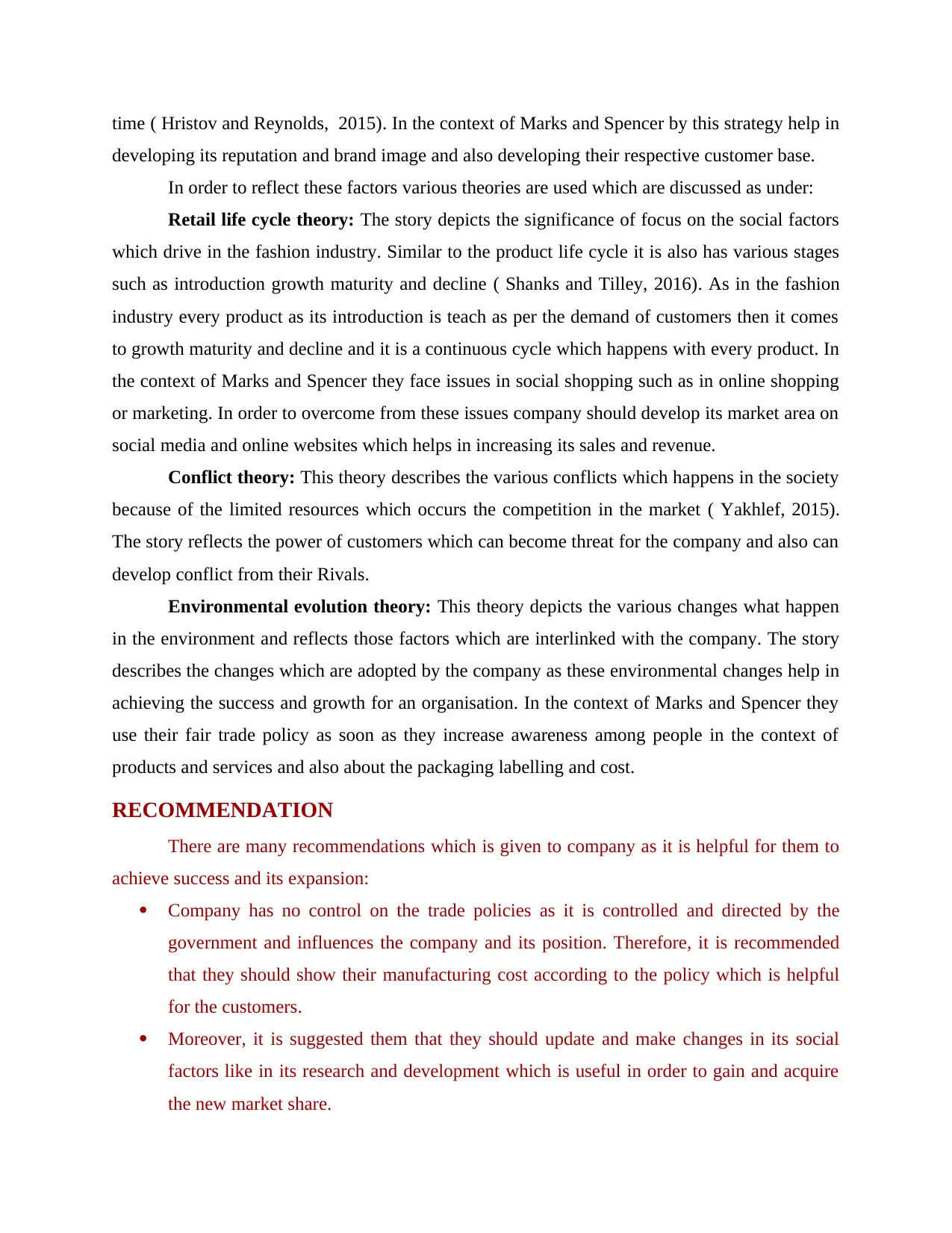
time ( Hristov and Reynolds, 2015). In the context of Marks and Spencer by this strategy help in
developing its reputation and brand image and also developing their respective customer base.
In order to reflect these factors various theories are used which are discussed as under:
Retail life cycle theory: The story depicts the significance of focus on the social factors
which drive in the fashion industry. Similar to the product life cycle it is also has various stages
such as introduction growth maturity and decline ( Shanks and Tilley, 2016). As in the fashion
industry every product as its introduction is teach as per the demand of customers then it comes
to growth maturity and decline and it is a continuous cycle which happens with every product. In
the context of Marks and Spencer they face issues in social shopping such as in online shopping
or marketing. In order to overcome from these issues company should develop its market area on
social media and online websites which helps in increasing its sales and revenue.
Conflict theory: This theory describes the various conflicts which happens in the society
because of the limited resources which occurs the competition in the market ( Yakhlef, 2015).
The story reflects the power of customers which can become threat for the company and also can
develop conflict from their Rivals.
Environmental evolution theory: This theory depicts the various changes what happen
in the environment and reflects those factors which are interlinked with the company. The story
describes the changes which are adopted by the company as these environmental changes help in
achieving the success and growth for an organisation. In the context of Marks and Spencer they
use their fair trade policy as soon as they increase awareness among people in the context of
products and services and also about the packaging labelling and cost.
RECOMMENDATION
There are many recommendations which is given to company as it is helpful for them to
achieve success and its expansion:
Company has no control on the trade policies as it is controlled and directed by the
government and influences the company and its position. Therefore, it is recommended
that they should show their manufacturing cost according to the policy which is helpful
for the customers.
Moreover, it is suggested them that they should update and make changes in its social
factors like in its research and development which is useful in order to gain and acquire
the new market share.
developing its reputation and brand image and also developing their respective customer base.
In order to reflect these factors various theories are used which are discussed as under:
Retail life cycle theory: The story depicts the significance of focus on the social factors
which drive in the fashion industry. Similar to the product life cycle it is also has various stages
such as introduction growth maturity and decline ( Shanks and Tilley, 2016). As in the fashion
industry every product as its introduction is teach as per the demand of customers then it comes
to growth maturity and decline and it is a continuous cycle which happens with every product. In
the context of Marks and Spencer they face issues in social shopping such as in online shopping
or marketing. In order to overcome from these issues company should develop its market area on
social media and online websites which helps in increasing its sales and revenue.
Conflict theory: This theory describes the various conflicts which happens in the society
because of the limited resources which occurs the competition in the market ( Yakhlef, 2015).
The story reflects the power of customers which can become threat for the company and also can
develop conflict from their Rivals.
Environmental evolution theory: This theory depicts the various changes what happen
in the environment and reflects those factors which are interlinked with the company. The story
describes the changes which are adopted by the company as these environmental changes help in
achieving the success and growth for an organisation. In the context of Marks and Spencer they
use their fair trade policy as soon as they increase awareness among people in the context of
products and services and also about the packaging labelling and cost.
RECOMMENDATION
There are many recommendations which is given to company as it is helpful for them to
achieve success and its expansion:
Company has no control on the trade policies as it is controlled and directed by the
government and influences the company and its position. Therefore, it is recommended
that they should show their manufacturing cost according to the policy which is helpful
for the customers.
Moreover, it is suggested them that they should update and make changes in its social
factors like in its research and development which is useful in order to gain and acquire
the new market share.
⊘ This is a preview!⊘
Do you want full access?
Subscribe today to unlock all pages.

Trusted by 1+ million students worldwide
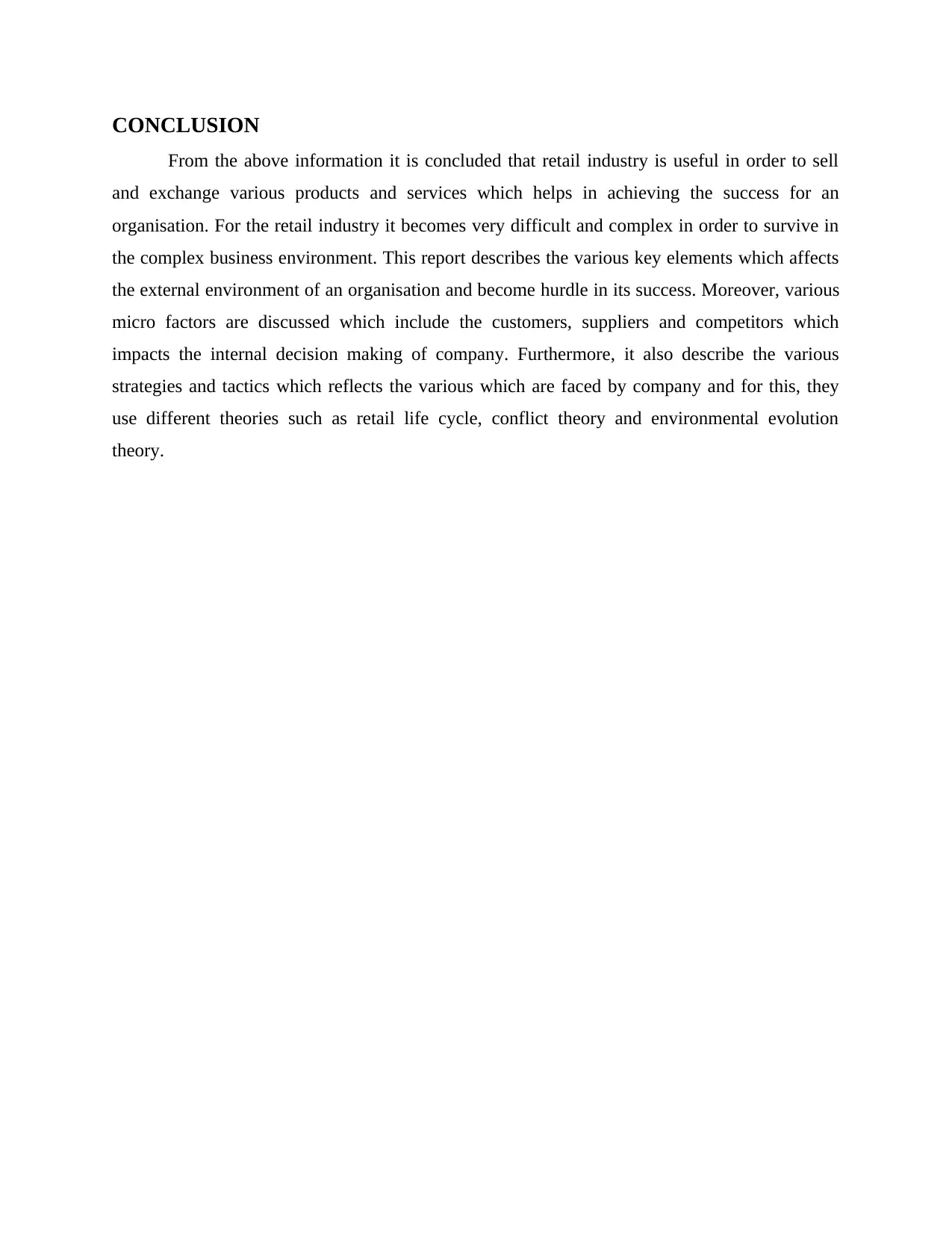
CONCLUSION
From the above information it is concluded that retail industry is useful in order to sell
and exchange various products and services which helps in achieving the success for an
organisation. For the retail industry it becomes very difficult and complex in order to survive in
the complex business environment. This report describes the various key elements which affects
the external environment of an organisation and become hurdle in its success. Moreover, various
micro factors are discussed which include the customers, suppliers and competitors which
impacts the internal decision making of company. Furthermore, it also describe the various
strategies and tactics which reflects the various which are faced by company and for this, they
use different theories such as retail life cycle, conflict theory and environmental evolution
theory.
From the above information it is concluded that retail industry is useful in order to sell
and exchange various products and services which helps in achieving the success for an
organisation. For the retail industry it becomes very difficult and complex in order to survive in
the complex business environment. This report describes the various key elements which affects
the external environment of an organisation and become hurdle in its success. Moreover, various
micro factors are discussed which include the customers, suppliers and competitors which
impacts the internal decision making of company. Furthermore, it also describe the various
strategies and tactics which reflects the various which are faced by company and for this, they
use different theories such as retail life cycle, conflict theory and environmental evolution
theory.
Paraphrase This Document
Need a fresh take? Get an instant paraphrase of this document with our AI Paraphraser
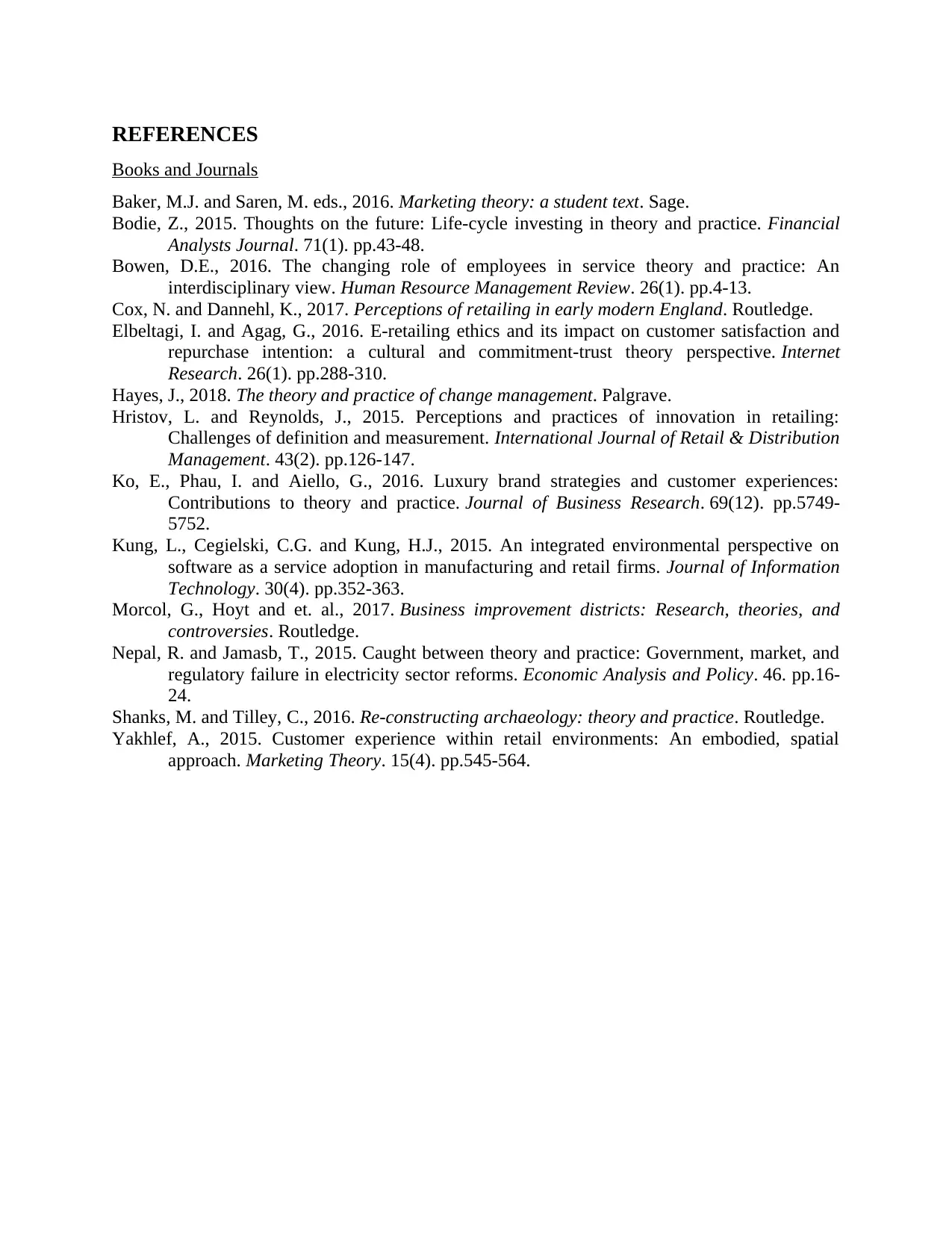
REFERENCES
Books and Journals
Baker, M.J. and Saren, M. eds., 2016. Marketing theory: a student text. Sage.
Bodie, Z., 2015. Thoughts on the future: Life-cycle investing in theory and practice. Financial
Analysts Journal. 71(1). pp.43-48.
Bowen, D.E., 2016. The changing role of employees in service theory and practice: An
interdisciplinary view. Human Resource Management Review. 26(1). pp.4-13.
Cox, N. and Dannehl, K., 2017. Perceptions of retailing in early modern England. Routledge.
Elbeltagi, I. and Agag, G., 2016. E-retailing ethics and its impact on customer satisfaction and
repurchase intention: a cultural and commitment-trust theory perspective. Internet
Research. 26(1). pp.288-310.
Hayes, J., 2018. The theory and practice of change management. Palgrave.
Hristov, L. and Reynolds, J., 2015. Perceptions and practices of innovation in retailing:
Challenges of definition and measurement. International Journal of Retail & Distribution
Management. 43(2). pp.126-147.
Ko, E., Phau, I. and Aiello, G., 2016. Luxury brand strategies and customer experiences:
Contributions to theory and practice. Journal of Business Research. 69(12). pp.5749-
5752.
Kung, L., Cegielski, C.G. and Kung, H.J., 2015. An integrated environmental perspective on
software as a service adoption in manufacturing and retail firms. Journal of Information
Technology. 30(4). pp.352-363.
Morcol, G., Hoyt and et. al., 2017. Business improvement districts: Research, theories, and
controversies. Routledge.
Nepal, R. and Jamasb, T., 2015. Caught between theory and practice: Government, market, and
regulatory failure in electricity sector reforms. Economic Analysis and Policy. 46. pp.16-
24.
Shanks, M. and Tilley, C., 2016. Re-constructing archaeology: theory and practice. Routledge.
Yakhlef, A., 2015. Customer experience within retail environments: An embodied, spatial
approach. Marketing Theory. 15(4). pp.545-564.
Books and Journals
Baker, M.J. and Saren, M. eds., 2016. Marketing theory: a student text. Sage.
Bodie, Z., 2015. Thoughts on the future: Life-cycle investing in theory and practice. Financial
Analysts Journal. 71(1). pp.43-48.
Bowen, D.E., 2016. The changing role of employees in service theory and practice: An
interdisciplinary view. Human Resource Management Review. 26(1). pp.4-13.
Cox, N. and Dannehl, K., 2017. Perceptions of retailing in early modern England. Routledge.
Elbeltagi, I. and Agag, G., 2016. E-retailing ethics and its impact on customer satisfaction and
repurchase intention: a cultural and commitment-trust theory perspective. Internet
Research. 26(1). pp.288-310.
Hayes, J., 2018. The theory and practice of change management. Palgrave.
Hristov, L. and Reynolds, J., 2015. Perceptions and practices of innovation in retailing:
Challenges of definition and measurement. International Journal of Retail & Distribution
Management. 43(2). pp.126-147.
Ko, E., Phau, I. and Aiello, G., 2016. Luxury brand strategies and customer experiences:
Contributions to theory and practice. Journal of Business Research. 69(12). pp.5749-
5752.
Kung, L., Cegielski, C.G. and Kung, H.J., 2015. An integrated environmental perspective on
software as a service adoption in manufacturing and retail firms. Journal of Information
Technology. 30(4). pp.352-363.
Morcol, G., Hoyt and et. al., 2017. Business improvement districts: Research, theories, and
controversies. Routledge.
Nepal, R. and Jamasb, T., 2015. Caught between theory and practice: Government, market, and
regulatory failure in electricity sector reforms. Economic Analysis and Policy. 46. pp.16-
24.
Shanks, M. and Tilley, C., 2016. Re-constructing archaeology: theory and practice. Routledge.
Yakhlef, A., 2015. Customer experience within retail environments: An embodied, spatial
approach. Marketing Theory. 15(4). pp.545-564.
1 out of 11
Related Documents
Your All-in-One AI-Powered Toolkit for Academic Success.
+13062052269
info@desklib.com
Available 24*7 on WhatsApp / Email
![[object Object]](/_next/static/media/star-bottom.7253800d.svg)
Unlock your academic potential
Copyright © 2020–2025 A2Z Services. All Rights Reserved. Developed and managed by ZUCOL.




